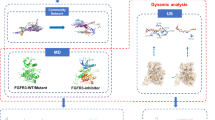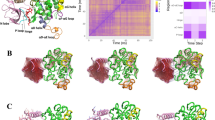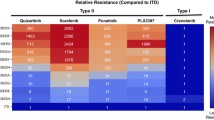Abstract
FMS-like tyrosine kinase 3 (FLT3) serves as an important drug target for acute myeloid leukemia (AML), and gene mutations of FLT3 have been closely associated with AML patients with an incidence rate of ~ 30%. However, the mechanism of the clinically relevant F691L gatekeeper mutation conferred resistance to the drug gilteritinib remained poorly understood. In this study, multiple microsecond molecular dynamics (MD) simulations, end-point free energy calculations, and dynamic correlated and network analyses were performed to investigate the molecular basis of gilteritinib resistance to the FLT3-F691L mutation. The simulations revealed that the resistant mutation largely induced the conformational changes of the activation loop (A-loop), the phosphate-binding loop, and the helix αC of the FLT3 protein. The binding abilities of the gilteritinib to the wild-type and the F691L mutant were different through the binding free energy prediction. The simulation results further indicated that the driving force to determine the binding affinity of gilteritinib was derived from the differences in the energy terms of electrostatic and van der Waals interactions. Moreover, the per-residue free energy decomposition suggested that the four residues (Phe803, Gly831, Leu832, and Ala833) located at the A-loop of FLT3 had a significant impact on the binding affinity of gilteritinib to the F691L mutant. This study may provide useful information for the design of novel FLT3 inhibitors specially targeting the F691L gatekeeper mutant.
Graphical abstract








Similar content being viewed by others
Data availability
The data are available from the corresponding author upon request.
References
Döhner H, Wei AH, Löwenberg B (2021) Towards precision medicine for AML. Nat Rev Clin Oncol 18:577–590
Uddin R, Darwish NHE, Mousa SA (2021) Acute myeloid leukemia mutations and future mechanistic target to overcome resistance. Curr Treat Options Oncol 22:76
Zhang L, Lakkaniga NR, Bharate JB et al (2021) Discovery of imidazo[1,2-a]pyridine-thiophene derivatives as FLT3 and FLT3 mutants inhibitors for acute myeloid leukemia through structure-based optimization of an NEK2 inhibitor. Eur J Med Chem 225:113776
Zhong Y, Qiu RZ, Sun SL et al (2020) Small-molecule Fms-like tyrosine kinase 3 inhibitors: an attractive and efficient method for the treatment of acute myeloid leukemia. J Med Chem 63:12403–12428
Wang A, Li X, Chen C et al (2017) Discovery of 1-(4-(4-Amino-3-(4-(2-morpholinoethoxy)phenyl)-1H-pyrazolo[3,4-d]pyrimidin-1-yl)phenyl)-3-(5-(tert-butyl)isoxazol-3-yl)urea (CHMFL-FLT3-213) as a highly potent type II FLT3 kinase inhibitor capable of overcoming a variety of FLT3 kinase mutant. J Med Chem 60:8407–8424
Daver N, Schlenk RF, Russell NH, Levis MJ (2019) Targeting FLT3 mutations in AML: review of current knowledge and evidence. Leukemia 33:299–312
Arai Y, Chi S, Minami Y, Yanada M (2022) FLT3-targeted treatment for acute myeloid leukemia. Int J Hematol. https://doi.org/10.1007/s12185-022-03374-0
Bruno S, Bandini L, Patuelli A et al (2021) Case report: a novel activating FLT3 mutation in acute myeloid leukemia. Front Oncol 11:728613
Al-Subaie AM, Kamaraj B (2021) The structural effect of FLT3 mutations at 835th position and their interaction with acute myeloid leukemia inhibitors: in silico approach. Int J Mol Sci 22:7602
Wang P, Xiao X, Zhang Y et al (2021) A dual inhibitor overcomes drug-resistant FLT3-ITD acute myeloid leukemia. J Hematol Oncol 14:105
Wang Z, Cai J, Cheng J et al (2021) FLT3 inhibitors in acute myeloid leukemia: challenges and recent developments in overcoming resistance. J Med Chem 64:2878–2900
Cohen P, Cross D, Jänne PA (2021) Kinase drug discovery 20 years after imatinib: progress and future directions. Nat Rev Drug Discov 20:551–569
Attwood MM, Fabbro D, Sokolov AV et al (2021) Trends in kinase drug discovery: targets, indications and inhibitor design. Nat Rev Drug Discov 20:839–861
Kiyoi H, Kawashima N, Ishikawa Y (2020) FLT3 mutations in acute myeloid leukemia: therapeutic paradigm beyond inhibitor development. Cancer Sci 111:312–322
Friedman R (2022) The molecular mechanisms behind activation of FLT3 in acute myeloid leukemia and resistance to therapy by selective inhibitors. Biochim Biophys Acta - Rev Cancer 1877:188666
Ahn J-S, Kim H-J (2022) FLT3 mutations in acute myeloid leukemia: a review focusing on clinically applicable drugs. Blood Res 57:32–36
Wang Z, Cai J, Ren J et al (2021) Discovery of a potent FLT3 inhibitor (LT-850-166) with the capacity of overcoming a variety of FLT3 mutations. J Med Chem 64:14664–14701
Cho H, Shin I, Yoon H et al (2021) Identification of thieno[3,2- d]pyrimidine derivatives as dual inhibitors of focal adhesion kinase and FMS-like tyrosine kinase 3. J Med Chem 64:11934–11957
Smith CC, Zhang C, Lin KC et al (2016) Characterizing and overriding the structural mechanism of the quizartinib-resistant FLT3 “gatekeeper” F691L mutation with PLX3397. Cancer Discov 5:668–679
Pulte ED, Norsworthy KJ, Wang Y et al (2021) FDA approval summary: gilteritinib for relapsed or refractory acute myeloid leukemia with a FLT3 mutation. Clin Cancer Res 27:3515–3521
Zavorka Thomas ME, Lu X, Talebi Z et al (2021) Gilteritinib inhibits glutamine uptake and utilization in FLT3-ITD-positive AML. Mol Cancer Ther 20:2207–2217
Tarver TC, Hill JE, Rahmat L et al (2020) Gilteritinib is a clinically active FLT3 inhibitor with broad activity against FLT3 kinase domain mutations. Blood Adv 4:514–524
Joshi SK, Sharzehi S, Pittsenbarger J et al (2021) A noncanonical FLT3 gatekeeper mutation disrupts gilteritinib binding and confers resistance. Am J Hematol 96:E226–E229
Yang K, Fu L (2015) Mechanisms of resistance to BCR-ABL TKIs and the therapeutic strategies: a review. Crit Rev Oncol Hematol 93:277–292
Jia Y, Yun C-H, Park E et al (2016) Overcoming EGFR(T790M) and EGFR(C797S) resistance with mutant-selective allosteric inhibitors. Nature 534:129–132
Mizuta H, Okada K, Araki M et al (2021) Gilteritinib overcomes lorlatinib resistance in ALK-rearranged cancer. Nat Commun 12:1261
Liu X, Wang B, Chen C et al (2019) Discovery of (E)- N1-(3-Fluorophenyl)- N3-(3-(2-(pyridin-2-yl)vinyl)-1 H-indazol-6-yl)malonamide (CHMFL-KIT-033) as a novel c-KIT T670I mutant selective kinase inhibitor for gastrointestinal stromal tumors (GISTs). J Med Chem 62:5006–5024
Novotny CJ, Pollari S, Park JH et al (2016) Overcoming resistance to HER2 inhibitors through state-specific kinase binding. Nat Chem Biol 12:923–930
Chong CR, Bahcall M, Capelletti M et al (2017) Identification of existing drugs that effectively target NTRK1 and ROS1 rearrangements in lung cancer. Clin Cancer Res 23:204–213
Kang D, Feng D, Ginex T et al (2020) Exploring the hydrophobic channel of NNIBP leads to the discovery of novel piperidine-substituted thiophene[3,2-d]pyrimidine derivatives as potent HIV-1 NNRTIs. Acta Pharm Sin B 10:878–894
Shi Y, Zhang X, Mu K et al (2020) D3Targets-2019-nCoV: a webserver for predicting drug targets and for multi-target and multi-site based virtual screening against COVID-19. Acta Pharm Sin B 10:1239–1248
Lu S, He X, Ni D, Zhang J (2019) Allosteric modulator discovery: from serendipity to structure-based design. J Med Chem 62:6405–6421
Lu S, Qiu Y, Ni D et al (2020) Emergence of allosteric drug- resistance mutations : new challenges for allosteric drug discovery. Drug Discov Today 25:177–184
Ni D, Li Y, Qiu Y et al (2020) Combining allosteric and orthosteric drugs to overcome drug resistance. Trends Pharmacol Sci 41:336–348
Qiu Y, Wang Y, Chai Z et al (2021) Targeting RAS phosphorylation in cancer therapy: mechanisms and modulators. Acta Pharm Sin B 11:3433–3446
Yang X, Zhong J, Zhang Q et al (2021) Advances and insights of APC-Asef inhibitors for metastatic colorectal cancer therapy. Front Mol Biosci 8:662579
Maloney RC, Zhang M, Jang H, Nussinov R (2021) The mechanism of activation of monomeric B-Raf V600E. Comput Struct Biotechnol J 19:3349–3363
Kawase T, Nakazawa T, Eguchi T et al (2019) Effect of Fms-like tyrosine kinase 3 (FLT3) ligand (FL) on antitumor activity of gilteritinib, a FLT3 inhibitor, in mice xenografted with FL-overexpressing cells. Oncotarget 10:6111–6123
Webb B, Sali A (2014) Protein structure modeling with MODELLER. Methods Mol Biol 1137:1–15
Bayly CI, Cieplak P, Cornell WD, Kollman PA (1993) A well-behaved electrostatic potential based method using charge restraints for deriving atomic charges: the RESP model. J Phys Chem 97:10269–10280
Case DA, Cheatham TE, Darden T et al (2005) The Amber biomolecular simulation programs. J Comput Chem 26:1668–1688
Maier JA, Martinez C, Kasavajhala K et al (2015) ff14SB: improving the accuracy of protein side chain and backbone parameters from ff99SB. J Chem Theory Comput 11:3696–3713
Wang J, Wolf RM, Caldwell JW et al (2004) Development and testing of a general amber force field. J Comput Chem 25:1157–1174
Jorgensen WL, Chandrasekhar J, Madura JD et al (1983) Comparison of simple potential functions for simulating liquid water. J Chem Phys 79:926
Shevchenko E, Poso A, Pantsar T (2020) The autoinhibited state of MKK4: phosphorylation, putative dimerization and R134W mutant studied by molecular dynamics simulations. Comput Struct Biotechnol J 18:2687–2698
Pan B, Fang S, Zhang J et al (2020) Chinese herbal compounds against SARS-CoV-2: puerarin and quercetin impair the binding of viral S-protein to ACE2 receptor. Comput Struct Biotechnol J 18:3518–3527
Feng L, Lu S, Zheng Z et al (2021) Identification of an allosteric hotspot for additive activation of PPARγ in antidiabetic effects. Sci Bull 66:1559–1570
Zhang Q, Chen Y, Ni D et al (2022) Targeting a cryptic allosteric site of SIRT6 with small-molecule inhibitors that inhibit the migration of pancreatic cancer cells. Acta Pharm Sin B 12:876–889
Darden T, York D, Pedersen L (1993) Particle mesh Ewald: an N.long(N)method for Ewald sums in large systems. J Chem Phys 98:10089–10092
Ryckaert J-P, Ciccotti G, Berendsen HJC (1977) Numerical integration of the Cartesian equations of motion of a system with constraints: molecular dynamics of n-alkanes. J Comput Phys 23:327–341
Wu X, Brooks BR (2003) Self-guided Langevin dynamics simulation method. Chem Phys Lett 381:512–518
Masterson LR, Shi L, Metcalfe E et al (2011) Dynamically committed, uncommitted, and quenched states encoded in protein kinase A revealed by NMR spectroscopy. Proc Natl Acad Sci U S A 108:6969–6974
Qiu Y, Yin X, Li X et al (2021) Untangling dual-targeting therapeutic mechanism of epidermal growth factor receptor (EGFR) based on reversed allosteric communication. Pharmaceutics 13:747
Li X, Qi Z, Ni D et al (2021) Markov state models and molecular dynamics simulations provide understanding of the nucleotide-dependent dimerization-based activation of LRRK2 ROC domain. Molecules 26:5647
Sethi A, Eargle J, Black AA, Luthey-Schulten Z (2009) Dynamical networks in tRNA: protein complexes. Proc Natl Acad Sci U S A 106:6620–6625
Kollman PA, Massova I, Reyes C et al (2000) Calculating structures and free energies of complex molecules: combining molecular mechanics and continuum models. Acc Chem Res 33:889–897
Wang E, Sun H, Wang J et al (2019) End-point binding free energy calculation with MM/PBSA and MM/GBSA: strategies and applications in drug design. Chem Rev 119:9478–9508
Xie T, Yu J, Fu W et al (2019) Insight into the selective binding mechanism of DNMT1 and DNMT3A inhibitors: a molecular simulation study. Phys Chem Chem Phys 21:12931–12947
Alaofi AL, Shahid M (2021) Mutations of SARS-CoV-2 RBD may alter its molecular structure to improve its infection efficiency. Biomolecules 11:1273
Mohammad A, Al-Mulla F, Wei DQ, Abubaker J (2021) Remdesivir md simulations suggest a more favourable binding to sars-cov-2 rna dependent rna polymerase mutant p323l than wild-type. Biomolecules 11:919
Cao S, Jiang X, Tan C et al (2021) How does nintedanib overcome cancer drug-resistant mutation of RET protein-tyrosine kinase: insights from molecular dynamics simulations. J Mol Model 27:337
Tian W, Liu X, Wang L et al (2021) Deciphering the selective binding mechanisms of anaplastic lymphoma kinase–derived neuroblastoma tumor neoepitopes to human leukocyte antigen. J Mol Model 27:134
Wang Y, Ji D, Lei C et al (2021) Mechanistic insights into the effect of phosphorylation on Ras conformational dynamics and its interactions with cell signaling proteins. Comput Struct Biotechnol J 19:1184–1199
He X, Huang N, Qiu Y et al (2021) Conformational selection mechanism provides structural insights into the optimization of APC-Asef inhibitors. Molecules 26:962
Li X, Ye M, Wang Y et al (2020) How Parkinson’s disease-related mutations disrupt the dimerization of WD40 domain in LRRK2: a comparative molecular dynamics simulation study. Phys Chem Chem Phys 22:20421–20433
Navarro G, Gonzalez A, Campanacci S et al (2020) Experimental and computational analysis of biased agonism on full-length and a C-terminally truncated adenosine A2A receptor. Comput Struct Biotechnol J 18:2723–2732
Lu S, Chen Y, Wei J et al (2021) Mechanism of allosteric activation of SIRT6 revealed by the action of rationally designed activators. Acta Pharm Sin B 11:1355–1361
Lu S, He X, Yang Z et al (2021) Activation pathway of a G protein-coupled receptor uncovers conformational intermediates as targets for allosteric drug design. Nat Commun 12:4721
Lu S, Ni D, Wang C et al (2019) Deactivation pathway of Ras GTPase underlies conformational substates as targets for drug design. ACS Catal 9:7188–7196
Ni D, Wei J, He X et al (2021) Discovery of cryptic allosteric sites using reversed allosteric communication by a combined computational and experimental strategy. Chem Sci 12:464–476
Byun JA, VanSchouwen B, Akimoto M, Melacini G (2020) Allosteric inhibition explained through conformational ensembles sampling distinct “mixed” states. Comput Struct Biotechnol J 18:3803–3818
Hossain KA, Jurkowski M, Czub J, Kogut M (2021) Mechanism of recognition of parallel G-quadruplexes by DEAH/RHAU helicase DHX36 explored by molecular dynamics simulations. Comput Struct Biotechnol J 19:2526–2536
Li X, Dai J, Ni D et al (2020) Insight into the mechanism of allosteric activation of PI3Kα by oncoprotein K-Ras4B. Int J Biol Macromol 144:643–655
Han Y, Wang Z, Wei Z et al (2021) Binding affinity and mechanisms of SARS-CoV-2 variants. Comput Struct Biotechnol J 19:4184–4191
Lee HG, Kang S, Lee JS (2021) Binding characteristics of staphylococcal protein A and streptococcal protein G for fragment crystallizable portion of human immunoglobulin G. Comput Struct Biotechnol J 19:3372–3383
Liu Q, Wang Y, Leung ELH, Yao X (2021) In silico study of intrinsic dynamics of full-length apo-ACE2 and RBD-ACE2 complex. Comput Struct Biotechnol J 19:5455–5465
Shao J, Tanner SW, Thompson N, Cheatham TE (2007) Clustering molecular dynamics trajectories: 1. Characterizing the performance of different clustering algorithms. J Chem Theory Comput 3:2312–2334
Li X, Wang C, Peng T et al (2021) Atomic-scale insights into allosteric inhibition and evolutional rescue mechanism of Streptococcus thermophilus Cas9 by the anti-CRISPR protein AcrIIA6. Comput Struct Biotechnol J 19:6108–6124
Wang Y, Li M, Liang W et al (2022) Delineating the activation mechanism and conformational landscape of a class B G protein-coupled receptor glucagon receptor. Comput Struct Biotechnol J 20:628–639
Acknowledgments
The authors highly appreciated the provided supercomputer resources by the Nanjing Medical University.
Author information
Authors and Affiliations
Contributions
Jinfeng Fu conceived and supervised the project; Shibo Zhou and Bo Yang designed and performed the project; Shibo Zhou, Bo Yang, Yufeng Xu, Aihua Gu, and Juan Peng performed simulations and analyzed the results; Shibo Zhou drafted the manuscript and Jinfeng Fu edited the manuscript.
Corresponding author
Ethics declarations
Conflict of interest
The authors declare no competing interests.
Additional information
Publisher's note
Springer Nature remains neutral with regard to jurisdictional claims in published maps and institutional affiliations.
Rights and permissions
Springer Nature or its licensor holds exclusive rights to this article under a publishing agreement with the author(s) or other rightsholder(s); author self-archiving of the accepted manuscript version of this article is solely governed by the terms of such publishing agreement and applicable law.
About this article
Cite this article
Zhou, S., Yang, B., Xu, Y. et al. Understanding gilteritinib resistance to FLT3-F691L mutation through an integrated computational strategy. J Mol Model 28, 247 (2022). https://doi.org/10.1007/s00894-022-05254-0
Received:
Accepted:
Published:
DOI: https://doi.org/10.1007/s00894-022-05254-0




